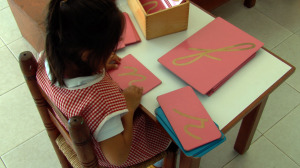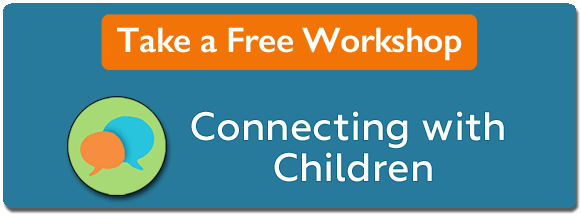
From birth to six, children are in a critical period of language development, when the spoken word develops naturally. Ninety percent of our adult conversational language is in place by the age of six. If a child does not speak by age six, it is improbable that the child will acquire spoken, written or sign language beyond a two-year-old’s comprehension level.
We don’t have to teach children to walk or talk. Children thrive in an environment that encourages walking and talking during this critical stage of development. In normal development, a child will say his first word around twelve months and by thirty months will talk in sentences.
When you are aware of your child’s built-in developmental abilities, you can be of invaluable assistance by making sure your child’s surroundings meet his developmental needs.
By thirty months of age, language is fully developed in the child. By thirty-six months, a child should be able to clearly speak in full sentences, with correct basic syntax (meaning words are spoken in meaningful order), and each sound in a word should be clear and intelligible.
Unfortunately, for many children this is not the case. Ear infections, a long illness, separation from parents, physical or environmental challenges can cause language delays. Luckily, the critical period for language acquisition continues for another three years. At thirty-six months analyze your child’s spoken language for areas that are weak and not fully developed. Once you recognize areas for language development, you can begin to enrich your child’s learning in purposeful ways.
If you see speech difficulties, make sure that your child has no physical problems receiving or communicating information.
Your pediatrician should be able to help you determine if vision, hearing, or muscle tone in the mouth and tongue are affecting language development.
After addressing any physical challenges, you can begin to enrich your child’s language environment and target specific skills.
Some of the most common language challenges that young children have are…
- Not pronouncing certain sounds clearly;
- Mispronouncing words, such as pasgetti for spaghetti;
- Using a sentence structure that omits certain parts of speech;
- Substituting a word like “thingy” or grunting when they don’t know a word.
If your child is having difficulty making certain sounds, singing a simple song, using just one word over and over again is a good exercise.
For example, if your child cannot say the ‘th” sound, sing “thank you” over and over again to the tune of “London Bridge is Falling Down”. Sing the word “with” to work on the ending sound, and the word “without” for internal sound practice. Make it fun and silly and in a few days you will begin to see an improvement in your child’s “th” sounds. If your child needs work with multiple sounds, concentrate on one at a time, adding one new sound per week while reviewing the previous ones.
To help with mispronounced words, be sure that everyone (siblings, grandparents, caregivers) speaks to your child using normal clear speech and does not use “baby talk”.
Some children’s mispronounced words are cute and funny, but don’t incorporate them into your speech. One of my difficult words to pronounce growing up was “yellow”. My four younger siblings naturally mimicked my speech, and thought that the correct pronunciation for the color of the sun was “lellow”. With my mother’s patient efforts, we learned to pronounce it correctly. If she only had nickel for every time she had to say ‘yellow’. Remember to use the correct word and no “baby-talk”. If it doesn’t sound cute on a thirty-year-old, don’t let it be cute on a three-year-old.
Omitting pronouns and prepositions is another language challenge.
If your child is saying things like “Me go play.” kindly restate the sentence as “Yes, you are going to play outside.” There is no need to force a child to repeat words or sentences after you. If your child sees and hears it the right way, he or she will soon be speaking it correctly.
If you hear your child stumbling on finding the right word, do vocabulary enrichment using cards and simple naming of items in your home.
Restate sentences with an appropriate word; “That handle thingy is called an umbrella.” Reading out loud to your child every day will also help strengthen vocabulary along with listening skills.
To aid in your child’s language development, be aware of how children naturally develop speech. Analyze your child’s speaking skills at age three, focusing on enunciation, pronunciation, grammar and vocabulary skills. Keep language rich in your home and target specific skills.
Then relax a little and let your child’s natural ability to create language get to work.


I want more people to read this! Such fundamental reminders for parents.
Thank you for a wonderful article, as usual.
Can you please elaborate on this line: “By thirty months of age, language is fully developed in the child.” Specifically, what do you mean by “fully developed”?
Thank you for this wonderful resource, and for your attention to my question.
Lori,
At 30 months a child usually can do the following (and more):
• Pronounces all the sounds in his native tongue.
• Has a spoken vocabulary of about 600 words.
• Names objects in his environment.
• Names actions: for example, go, get, kiss, hug.
• Asks where and why.
• Uses comparatives like big and little.
• Uses simple sentences with subject/verb: Mommy goes to work.
• Uses all parts of speech: noun, verb, adverb, conjunction, prepositions, adjective, article, interjection
• Uses the plural forms of the noun
• Uses the past tense of the verb, both regular and irregular form: For example, came, broke, sat, went, fell; talked, walked,
• Uses preposition to show relationships between objects: Ball in water.
• Uses the possessive form of the noun: Mommy’s hat.
• Uses articles with noun: I see a dog.
• Uses 3rd person singular: Mommy smiles. Daddy is laughing.
• Uses verb contractions: That’s my doll.
• Follows 2-step related directions: Get your pajamas and bring them to me.
• Uses language to ask for help.
• Understands language connection with books.
• And more.
At 30 months, the child possesses the foundational language components that allow him to move forward in his language development: increased vocabulary, longer narratives, more complex sentence structure, enlargement of receptive language.
Really quite an amazing feat!
At 36 months the child will make few grammatical errors and we see quite an explosion of language from this 30 to 36 month period.
Hope this helps. Please let me know if you have any other question.
This is one of the most useful references I saw on the subject. Thank you for such a detailed reply. Would you have any similar references for other area (math?). As a parent, it is often hard to bridge the abstract concepts into actionable steps.
Tatyana,
I have more resources about language development at my finger tips than math development from birth through age 3.
Give me a couple of days and I’ll pull something together.
But it does bring up the idea of how our culture tends to overlook key math building experiences for our under three-year-olds.
Thank you very much for this detailed response!
Tatyana,
Here’s a few touchstones for math development in our 3 to 5 year olds.
Age 3 to 4
Child can count a collection of 1 to 4 items. Counting past four items usually is about memorizing a string of words and not about connecting a quantity with a number name.
Child begins to learn names of two and three dimensional items.
Can compare items and state which of two items is longer or heavier.
Can sort objects and compare the differences.
Ages 4 to 4.5
Child can add two quantities by counting all of the items. For example counting four cookies on one plate and three on another to count to seven.
Can see that the faces of three dimensional items are two dimensional shapes. For example, the faces of a cube are squares. The faces of a pyramid are triangles.
Can compare length of an item with multiple units of measurement. For example, the rug is five shoes long . The child needs five shoes to make this comparison.
Can classify items into categories. For example, items needed to make a cake, things you might see at a birthday party, items made out of metal.
Learning directional words like up, down, over, under, and many others.
Ages 4.5 to 5 years
Can recognize small quantities and then add to them by counting out the next quantity. For example, five fingers up on one hand, three on the other. Child Recognizes five and counts six, seven, eight on the other hand.
Can use two dimensional shapes, such as a tangram, to make a variety of shapes.
Uses standard measuring tools like a ruler and measuring tape and can tell you that the rug is 3 feet long.
Can connect a quantity with its number symbol from one to ten. For example: can place one penny next to the symbol for 1, two pennies next to 2, etc.
Thank you for following up on this question with such a detailed reply. I need to read up on Montessori at home references to start practicing these at home.
Thank you for sharing. The article was very informative.
Is there any of your newsletters that I can refer to for a child who is one year and six months and never lets go of a small cup.
She holds on to this while eating, playing almost always. I was wondering about this.
Would really appreciate your thoughts on this.
Regards,
Priya
Priya,
Aloha!
What you may be seeing is an attachment to an object associated with the child’s mother or father.
When she is holding the cup it may be helping her emotionally deal with being away from her mother.
Perhaps this article about the sensitive period for order might be helpful. There I talk about a three-year-old and her blanket.
https://marenschmidt.com/2015/02/sensitive-periods-understanding-a-childs-sense-of-order/
Hope this helps.